After the Ukrainian nationalist made a successful attempt on the life of Interior Minister Bronisław Pieracki, the Polish authorities decided to establish a detention camp in Bereza Kartuska. Just yesterday we had the anniversary of this event, because "the only Polish concentration camp" (as it is sometimes referred to in the literature) was established by the ordinance of President Mościcki on June 17, 1934. Let us recall in a few words maybe not so much how it was lived in it, but. .. how did you eat.
It was located in a corner of the country that is difficult to access and distant from civilization - in Polesie. The person of the voivode of Polesie, Wacław Kostek-Biernacki, who became famous for the "proper" treatment of Brześć prisoners in 1930, was also important here. Biernacki was neither the founder nor the commandant of the camp - it is worth remembering.
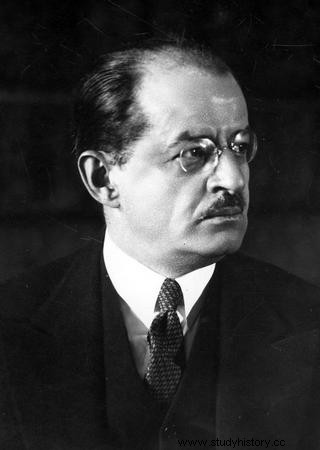
The initiator of the establishment of the Bereza camp was Prime Minister Leon Kozłowski.
The camp functioned from July 12, 1934 until the Red Army entered its territory in September 1939. About 3,000 people passed through it until the outbreak of the war. According to the originators, it was intended to keep destroyers of public order and security (Announcement of the voivode of Polesie, Wacław Kostek-Biernacki, "Word", No. 188, July 13, 1934).
It happened there without a court order. This procedure aroused much controversy then and nowadays, bringing to mind concentration camps functioning in the Third Reich (not to be confused with death camps).
What can you eat for 28 cents?
The fate of inmates was the cause of many polemics and discussions, both in the press and in the parliamentary tribunal. One of the "hot" topics was the question of feeding the detainees. Initially, the daily rate for this purpose was set at PLN 0.28. The press immediately pointed out to the government that this was less than for criminal prisoners convicted of serious crimes.
It was argued that such an amount was not enough to support a hard-working person (prisoners performed a number of physical work). The authorities tried to defend themselves, arguing that the quality of meals served in Bereza is much higher than in normal prisons. In the end, the government yielded to public pressure and the daily allowance was raised to PLN 0.49.
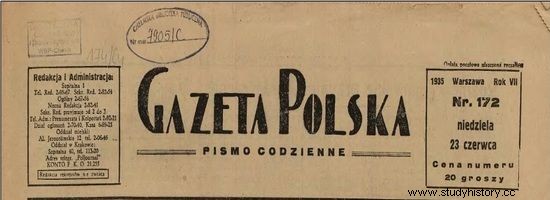
(…) We know what must be in Poland, because we want it to. There must be order. It has to be serious and it will be. Concentration camps. Yes. Why? Because you can see those eight years of work on the greatness of Poland, eight years of example and eight years of achievements, eight years of solidification - it was not enough for everyone (...) (Quoted in:Gazeta Polska, No. 168, June 19, 1934).
These numbers probably seem abstract to many. What was the value of PLN 0.28 or PLN 49 at that time? Generally speaking, the pre-war zloty corresponded to 9-10 the current zloty. So initially camp prisoners were fed the equivalent of less than three today's zlotys a day!
But what exactly could you buy for less than 50 groszy? The prices of some products at the Krakow market (of course in Polesie they were lower) from August 14, 1934 give us some idea about this. For example, a liter of raw milk cost 12-18 grosze, an egg 4-6 grosz, a kilogram of potatoes and carrots 8 -10 grams, a kilogram of apples 20-60 gros, a kilogram of dessert butter 2.2-2.4 zlotys and, for example, a hen 2-3 zlotys.
Let us also have a look at "Price statistics" for the third quarter of 1934, published by the Central Statistical Office. For a kilogram of rye bread in Warsaw - in detail - PLN 0.33 was paid in August, a kilogram of wheat flour cost PLN 0.19 (i.e. as much as the daily food rate in the camp) , a kilogram of sugar PLN 1.44, a kilogram of bacon 1.4 PLN, and a kilogram of coffee - a trifle - PLN 7.2.
Camp diet
Let's get to the point:how was the food for the 49 groszy? Here we are helped by the article by Wojciech Śleszyński, Retreat camp in Bereza Kartuska 1934-1939 , report of the economic manager of the camp in Bereza of January 20, 1939:
This article has more than one page. Please select another one below to continue reading.Attention! You are not on the first page of the article. If you want to read from the beginning click here.
Report on the nutrition of the isolated on January 20, 1939
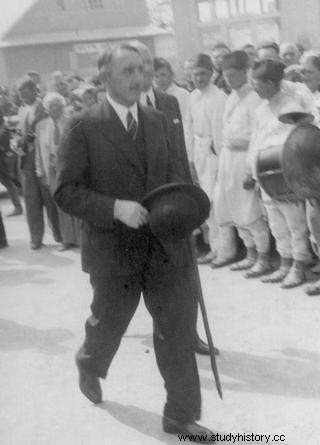
It is no coincidence that the place of the isolation was located in Bereza Kartuska. It was important that the voivode of Polesie was the famous Kostek-Biernacki.
General condition:483
at Kobrin 4 Hospital
General food 479
of which right 466
Fast (bread and water) 13
Released
Breakfast - Coffee
Coffee for 1 isolated 25 grams for 446 [error, it should be 466 - ed. author of the article] isolated 1,365 kg [error, it should be 11,650 kg - ed. of the author of the article.]
Sugar per 1 person 25 grams per 466 isolated 1.365 kg [as above - note author of the article.]
Bread for 1 person 700 grams for 466 people who are isolated 330.750 kg
Cottage cheese for 1 person 50 grams for 466 people who are isolated 23.300 kg
Lunch - Dumplings
Flour flour per 1 isolated 120 grams per 466 isolated 55.920 kg
Potatoes per 1 isolated 500 grams per 466 isolated 230,000 kg
Lard per 1 isolated 40 grams per 466 isolated 18.640 kg
Salt per 1 isolated 30 grams per 466 isolated 13.980 kg
Onions per 1 isolated 10 grams per 466 isolated 46.660
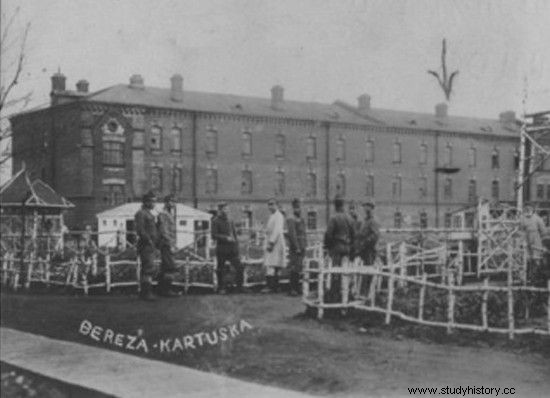
Wikt served to inmates in Bereza was very vegetarian, as a result of which many of them fell blind.
Dinner - Krupnik
Potatoes per 1 isolated 1000 grams per 466 isolated 466,000 kg
Lard per 1 isolated 15 grams per 466 isolated 9.990 kg [error, it should be 6.990 kg - ed. author of the article.]
Pearl barley per 1 single 100 grams per 466 isolated 46.600 kg
Cost
The cost of meals for 1 person isolated on January 20 is PLN 49.48.
Bereza Kartuska, January 20, 1939
Head of the Farm Department
/ - / A. Pruchniewicz, post-graduate
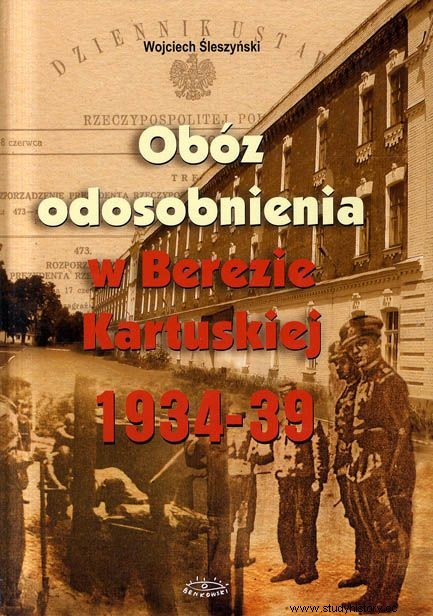
The article is based mainly on the book by Wojciech Śleszyński entitled "Retreat camp in Bereza Kartuska. 1934-1939 ”, Białystok 2001.
As we can see, the diet was rather vegetarian. Lack of meat and a sufficient amount of fats combined with high physical effort resulted in frequent occurrence of the so-called night blindness. However, the real bane was diarrhea and constipation. Especially that in Bereza, the use of the toilet was strictly dependent on the regulations and the whims of the guards.
The report also mentions 13 "fasting" people. It was a "reward" for various kinds of offenses, for which there was a series of penalties. It was relatively tolerable to be arrested with a normal food ration one day, dry bread and water three times the next.
The worst thing was to get to the penitentiary in the old cellar. It consisted of four rooms without windows, without any furniture, with a damp floor, additionally covered with water. The "inmate" of the prison could count on 350 grams of stale bread and a cup of water every other day, or a camp ration reduced by half.
